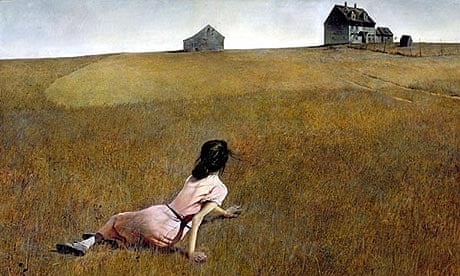When my teacher was introducing some of the artists that we could research, he mentioned Andrew Wyeth. For some reason, that name sounded super familiar and he was listed under the category of NARRATIVE figurative artists. When I looked up his work, I realized his name was familiar because I've seen many of his works. The painting of a dog on a bed, entitled Master Bedroom, is one I've seen many times because a print of it hangs over the headboard in my in-law's bedroom.
Andrew Wyeth lived in the Northeast, and his family was very wealthy. His granddaughter, Victoria, reminisced in an article in VOGUE about how they would go to their families private island every summer (article). His father was a famous artist, N.C. Wyeth, he largely painted illustrations for books and magazines. Because of his father's fame, Andrew was able to come in contact with many famous creatives of the day like F. Scott Fitzgerald and Mary Pickford. His father died in a tragic accident and soon after this event his art became more mature and took on the style that defined the art he is known for.
Andrew Wyeth died only a few years ago in 2009. He lived to be 91 years old. He was known as a realist painter, but considered himself an abstract painter. I agree with the second title because although his pictures are nearly true to life, he would depart from reality in his use of muted tones and scenes that seemed to create a world of their own- apart from the real world.
I can honestly say that I didn't know Wyeth as someone who was known to paint the human form, I didn't really think of his art in this way. But after looking at more examples of his work, I understand how essential and important the human form was to the depiction of rural and small-town America that he was known for.
A painting that he is well known for is a painting of a woman in a field far away from the homestead that is in the distance. The painting is named Christina's World (1948) after a family friend who lived in the farm next to the Wyeth farm in Maine. She had been crippled from polio and she would drag herself across the field near her home. Andrew saw this and asked her if he could paint this scene- a perfect story in a painting of the world that belonged to Christina Olson.
Formally, his color choses of muted earth tones work really well in adding to the narrative of rural America. I also think that it works well to capture the era that many of his paintings were created in: Depression, war-time, and post-war small-town America. He has some portraits, but most of his work depicts scenes and stories, so the composition of his work is essential in telling the story. Even though we are naturally drawn to the human figure in his work, they often only take up 20% of the composition- often less - and are usually in motion (not literally, but his style creates the feeling of motion).
 |
| Master Bedroom (1965) Andrew Wyeth |
Andrew Wyeth lived in the Northeast, and his family was very wealthy. His granddaughter, Victoria, reminisced in an article in VOGUE about how they would go to their families private island every summer (article). His father was a famous artist, N.C. Wyeth, he largely painted illustrations for books and magazines. Because of his father's fame, Andrew was able to come in contact with many famous creatives of the day like F. Scott Fitzgerald and Mary Pickford. His father died in a tragic accident and soon after this event his art became more mature and took on the style that defined the art he is known for.
Andrew Wyeth died only a few years ago in 2009. He lived to be 91 years old. He was known as a realist painter, but considered himself an abstract painter. I agree with the second title because although his pictures are nearly true to life, he would depart from reality in his use of muted tones and scenes that seemed to create a world of their own- apart from the real world.
I can honestly say that I didn't know Wyeth as someone who was known to paint the human form, I didn't really think of his art in this way. But after looking at more examples of his work, I understand how essential and important the human form was to the depiction of rural and small-town America that he was known for.
A painting that he is well known for is a painting of a woman in a field far away from the homestead that is in the distance. The painting is named Christina's World (1948) after a family friend who lived in the farm next to the Wyeth farm in Maine. She had been crippled from polio and she would drag herself across the field near her home. Andrew saw this and asked her if he could paint this scene- a perfect story in a painting of the world that belonged to Christina Olson.
Formally, his color choses of muted earth tones work really well in adding to the narrative of rural America. I also think that it works well to capture the era that many of his paintings were created in: Depression, war-time, and post-war small-town America. He has some portraits, but most of his work depicts scenes and stories, so the composition of his work is essential in telling the story. Even though we are naturally drawn to the human figure in his work, they often only take up 20% of the composition- often less - and are usually in motion (not literally, but his style creates the feeling of motion).
 |
| Christina's World (1948) Andrew Wyeth |
Comments
Post a Comment